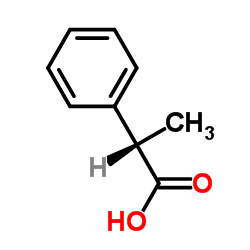(S)-2-Phenylpropanoic acid

(S)-2-Phenylpropanoic acid structure
|
Common Name | (S)-2-Phenylpropanoic acid | ||
|---|---|---|---|---|
| CAS Number | 7782-24-3 | Molecular Weight | 150.174 | |
| Density | 1.1±0.1 g/cm3 | Boiling Point | 261.0±0.0 °C at 760 mmHg | |
| Molecular Formula | C9H10O2 | Melting Point | 29-30 °C(lit.) | |
| MSDS | Chinese USA | Flash Point | 154.3±13.9 °C | |
| Symbol |

GHS07 |
Signal Word | Warning | |
|
Production of S-(+)-2-phenylpropionic acid from (R,S)-2-phenylpropionitrile by the combination of nitrile hydratase and stereoselective amidase in Rhodococcus equi TG328.
Appl. Microbiol. Biotechnol. 39(6) , 720-5, (1993) A new soil isolate, tentatively identified as Rhodococcus equi TG328, was found to be effective in the production of S-(+)-2-phenylpropionic acid from (R,S)-2-phenylpropionitrile. The conversion is catalysed by two enzymes. First, a nitrile hydratase converts... |
|
|
Stereoselective metabolism of 2-phenylpropionic acid in rat. I. In vitro studies on the stereoselective isomerization and glucuronidation of 2-phenylpropionic acid.
Drug Metab. Dispos. 15(4) , 529-34, (1987) Optical isomerization of 2-phenylpropionic acid (hydratropic acid, HTA) was studied in the organs of male rat in vitro. (R)-(-)-HTA was not isomerized by rat liver homogenate even after the addition of CoA, ATP, and Mg2+ to the incubation mixture; however, it... |
|
|
Substrate specificity and enantioselectivity of arylcarboxylic acid glucuronidation.
Drug Metab. Dispos. 16(4) , 627-34, (1988) A general and sensitive HPLC method using a precolumn switching system was developed for the separation and quantification of the individual diastereoisomeric glucuronides of the 2-phenylpropionic acid optical isomers. Kinetic properties of rat liver glucuron... |
|
|
Enantioselective covalent binding of 2-phenylpropionic Acid to protein in vitro in rat hepatocytes.
Chem. Res. Toxicol. 15(11) , 1480-7, (2002) A series of studies was conducted to investigate the potential of (R)- and (S)-2-phenylpropionic acid (2-PPA) to undergo enantioselective covalent binding to protein in freshly isolated rat hepatocytes and to determine whether such covalent binding is depende... |
|
|
Application and comparison of high performance liquid chromatography and high speed counter-current chromatography in enantioseparation of (±)-2-phenylpropionic acid.
J. Chromatogr. A. 1281 , 79-86, (2013) High performance liquid chromatography (HPLC) and high speed counter-current chromatography (HSCCC) were applied and compared in enantioseparation of 2-phenylpropionic acid (2-PPA) when hydroxypropyl-β-cyclodextrin (HP-β-CD) was used as chiral mobile phase ad... |
|
|
Stereoselective metabolism of 2-phenylpropionic acid in rat. II. Studies on the organs responsible for the optical isomerization of 2-phenylpropionic acid in rat in vivo.
Drug Metab. Dispos. 15(4) , 535-9, (1987) The contribution of the liver and kidney to the optical isomerization of (R)-(-)-2-phenylpropionic acid (hydratropic acid (HTA] was examined by iv injection of racemic HTA (20 mg/kg) to nephrectomized and bile duct-ligated rats (NEBL-rats), eviscerated rats w... |
|
|
In vivo mechanistic studies on the metabolic activation of 2-phenylpropionic acid in rat.
J. Pharmacol. Exp. Ther. 305(1) , 250-6, (2003) Two alternative metabolic pathways, acyl glucuronidation and acyl-CoA formation, are implicated in the generation of reactive acylating metabolites of carboxylic acids. Here, we describe studies that determine the relative importance of these two pathways in ... |
|
|
Formation of glycine conjugate and (-)-(R)-enantiomer from (+)-(S)-2-phenylpropionic acid suggesting the formation of the CoA thioester intermediate of (+)-(S)-enantiomer in dogs.
Chirality 4(6) , 342-8, (1992) It has been proposed that the chiral inversion of the 2-arylpropionic acids is due to the stereospecific formation of the (-)-R-profenyl-CoA thioesters which are putative intermediates in the inversion. Accordingly, amino acid conjugation, for which the CoA t... |
|
|
Microbial metabolism of 2-arylpropionic acids: chiral inversion of ibuprofen and 2-phenylpropionic acid.
Chirality 5(8) , 596-601, (1993) The metabolism of (R,S)-ibuprofen has been investigated in 24 microbial cultures. Of these Cunninghamella elegans, Mucor hiemalis, and Verticillium lecanii catalyzed the oxidation of the drug to 2-[4-(2-hydroxy-2-methylpropyl)phenyl]propionic acid, a known ma... |
|
|
Differential effects of fibrates on the metabolic activation of 2-phenylpropionic acid in rats.
Drug Metab. Dispos. 36(4) , 682-7, (2008) A series of studies were conducted to explore the inductive potential of different fibric acid derivatives on the two alternative metabolic activation pathways of 2-phenylpropionic acid (2-PPA) (a model substrate for profen drugs), namely acyl-CoA formation a... |